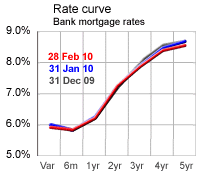 A flood of money from mortgage fixing may be pending as borrowers rush to fix mortgage rates ahead of wholesale rate rises, ANZ National economists have warned. ANZ, National Bank and ASB have raised fixed mortgage rates in the last few days, and there is an expectation that a flood of money will try to beat the collective market moving up, they said. A rush of mortgage fixing could force up wholesale interest rates and banks are likely to be more responsive to these rises than they were when there was a rush to fix in March, effectively dampening the incentive or opportunity to fix, they said. However, the pending flood of mortgage fixing would not have the same high levels as seen in March because of the current steepness of the rate curve, with the gap between one-year and five-year rates having widened over the year (see second tab of chart below). See all mortgage rates here.
A flood of money from mortgage fixing may be pending as borrowers rush to fix mortgage rates ahead of wholesale rate rises, ANZ National economists have warned. ANZ, National Bank and ASB have raised fixed mortgage rates in the last few days, and there is an expectation that a flood of money will try to beat the collective market moving up, they said. A rush of mortgage fixing could force up wholesale interest rates and banks are likely to be more responsive to these rises than they were when there was a rush to fix in March, effectively dampening the incentive or opportunity to fix, they said. However, the pending flood of mortgage fixing would not have the same high levels as seen in March because of the current steepness of the rate curve, with the gap between one-year and five-year rates having widened over the year (see second tab of chart below). See all mortgage rates here.
In June, $37.5 billion of mortgages were on floating rates (24 percent of the total). This is up from $19.6 billion a year earlier (or 13 percent of the total). In addition, a further $58.2 billion of fixed mortgages are due to roll off in the next 12 months. Hence, collectively there is around $90 billion of mortgages that could potentially be fixed. (In March) Concerns that interest rates were set to rise and a reasonably upbeat statement from RBNZ Governor Bollard (at the time) led to a belief that borrowers had "missed the boat" on achieving low rates. During the month, there was an $8.8 billion reduction in mortgages on floating rates or with less than one-year to reset. This contributed to local swap rates rising up to 50bps over the month. While no one can really accurately say how much payside pressure accounted for this move, it clearly accentuated market movements at the time. In March there was a window of opportunity between the wholesale curve moving and actual lending rates rising. We expect banks to be far quicker this time around, in effect dampening the incentive (or opportunity) to fix. One of the reasons for the sharp reaction in wholesale rates in March was that the move by borrowers into the 5-year rate meant that traders had to try to clear this through the most liquid part of the curve and had to pay roughly twice as much 2-year to maintain duration. This time around, the shape of the mortgage curve is steep enough for us to believe a shift into 5-year fixing is not likely. Mortgage related paying remains a flow side risk to the local swaps market, particularly as we suspect the market remains "long". The large number on floating mortgages can effectively fix at any time without incurring break fees. While there is potential for mortgage related fixing to provide some underlying payside support to shorter-term swap rates (2-years and below) we doubt we will see the same flood as was the case in March, given the current steepness of the mortgage curve and other differentiating factors.

We welcome your comments below. If you are not already registered, please register to comment
Remember we welcome robust, respectful and insightful debate. We don't welcome abusive or defamatory comments and will de-register those repeatedly making such comments. Our current comment policy is here.